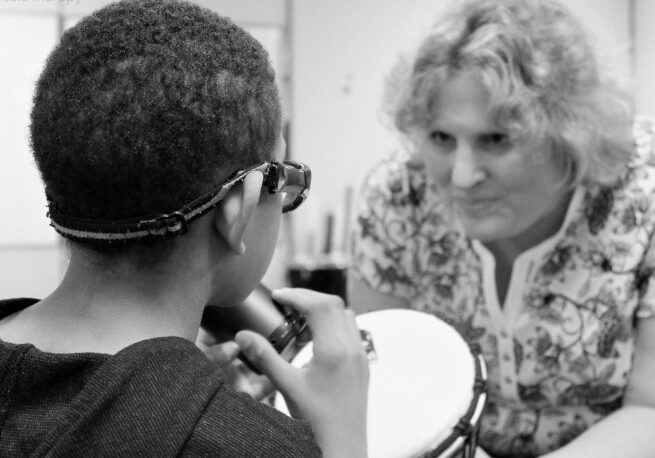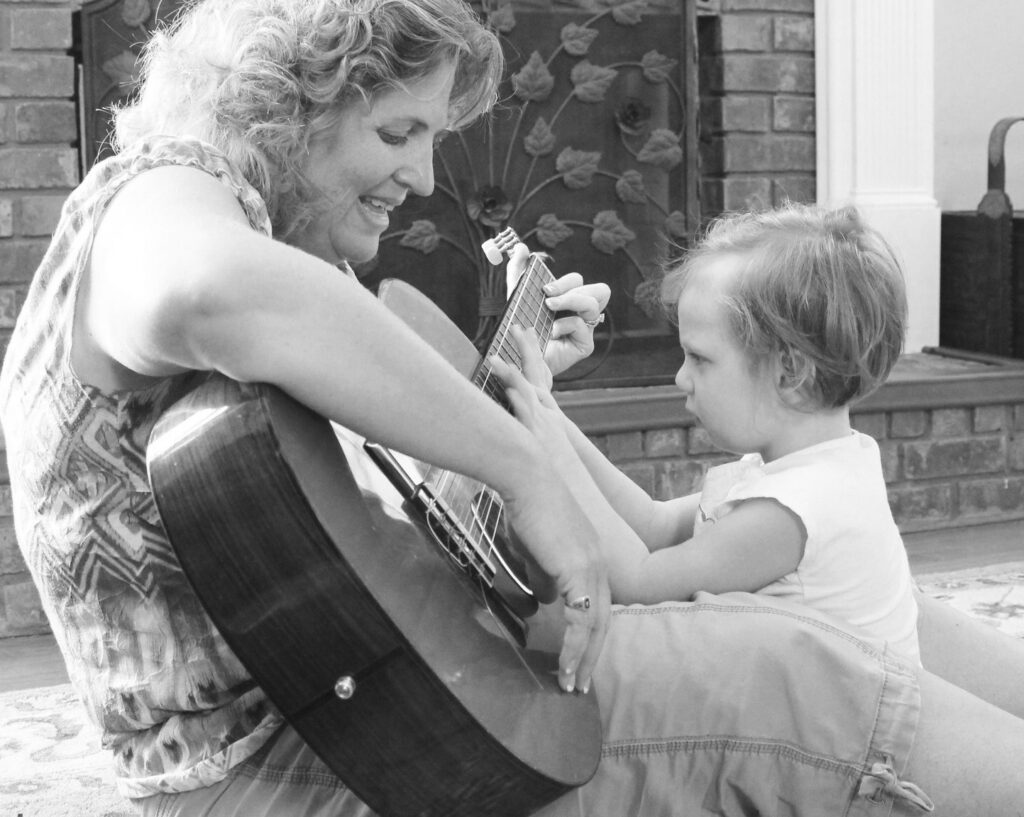Q & A with Laura Lenz
Aria Therapeutic Programming Manager
Forty years later, (that just hit me…almost to the day, 40 years!) what do I tell those who say, “Music therapy? What is that?” Well, there is the official definition from our guiding, national organization, The American Music Therapy Association: Music Therapy is the clinical & evidence-based use of music interventions to accomplish individualized goals within a therapeutic relationship by a credentialed professional who has completed an approved music therapy program. But, most of the time, I start off by saying pretty much the same words I was told forty years ago: “I use music to help people.”
Perhaps being a bit older and more knowledgeable now, I add in a few more details and find myself saying some version of, “Music has a profound impact on the brain and the body. Human beings are primed and impacted by the different aspects of music: rhythm, melody, pitch, timbre, harmonics, dynamics, lyrics, meter, structure, etc. Our brains naturally respond to these elements and, as a music therapist, I’m trained to understand and utilize these tools to help people in whatever way possible.” I also never leave the conversation without mentioning the emotional impact music has on our lives, and by asking them about how music has impacted them over the years. Finding people’s connection to music, no matter how small, always helps to guide my conversation about this somewhat unconventional field.

2) Naomi: A few years ago, I had the opportunity of observing you as you led a session with a wounded veteran. I witnessed you drawing out the life and wonders of a particular personality for a man, when severe injury left him with only the physical ability to move a finger, with slight mobility of a thumb, if I remember correctly. Why is music able to do this in a way that conversation and attention cannot seem to accomplish?
Laura: This brings back such wonderful memories! This Veteran has since left us, but I am, still to this day, struck by the profound impact music had in his life. It was for this reason that he was referred to music therapy and I remember my first day meeting him as if it was yesterday! I went to his home, which, in itself, is such an honor. Working with someone in their own home, surrounded by pictures and memories of them prior to their injuries…it’s so profound and humbling. His wife, who I am still in contact with to this day, told me story after story that depicted a larger than life personality, a wicked sense of humor, and a devoted, loving family man. All the while, I was sitting by his home hospital bed and smiling at a man who couldn’t speak, walk, or hold his six year old daughter anymore. After lots of conversation and a glance at the music downloaded on the prized Ipod he always had with him overseas, I played a few songs that I knew he liked. His head, which was typically held tilted somewhat to the left, swung around to where I was sitting on his right. He stared at me for the next 20-30 minutes before I had to leave. No smile, not the slightest facial expression…nothing…just that deep stare. I have to admit that my heart dropped a bit and, as I said goodbye and packed up my things, I turned to his wife and asked if she would like me to come back, honestly thinking this would be a “don’t call us, we’ll call you” moment. But in a heartbeat, she said “Are you kidding? Absolutely!!! If he didn’t like it, he wouldn’t have even looked at you! He couldn’t take his eyes off you!” I hope I (professionally of course!) hid my shock and, taking some new found wisdom with me, I left the house. Within a month of visits, his wife asked if I could come twice a week. I had almost five years of twice weekly visits with him before he passed. Why did music impact him so much? Well, let’s go back to some of the information I mentioned in that first question.
He, like so many others, had a deep, emotional connection to music. It brought him great joy, songs/artists/lyrics impacted him at many different levels, and he loved sharing that connection with others. Music is a whole brain activity; meaning that there is no one, special “music” center in the brain. Most individual parts of the brain can be connected to different elements of music. Speaking only hemispherically, the left side of your brain controls speech, math, science, logic, sense of time, etc., and the right side of your brain is that creative center: artistic, emotional, intuitive, and spatial. But doesn’t music have mathematical connections? And logic? And isn’t it rhythmic/timed? Of course it is! Researchers are fascinated (and with good reason!) with how music is processed in the brain. Despite his severe traumatic brain injury, music- and all its vast list of elements- was still processing and resonating in his brain with a strength that allowed him to laugh at funny songs (“inappropriate song day” was always a favorite!), move that index finger to make music, and mouth some word approximations to favorite songs. Truly awe inspiring, indeed, and someone who I still think about when I explain to others how strong the impact of music is on the brain.
3) Naomi: In his book, Musicophilia: Tales of Music and the Brain, Dr. Oliver Sacks (whose groundbreaking work inspired the 1990 film Awakenings) says, “Music is part of being human.” Many would say they aren’t musically talented; some might even say music doesn’t resonate with them. How does that relate to Dr. Sacks’ declaration?
Laura: I love this question because it is so important to note that music therapy, even though I truly believe it can be helpful to everyone, isn’t always the right choice for everyone! Salmon is one of the healthiest foods you can eat, but I just can’t bring myself to force it down! Our subjective decisions often make decisions for us and human beings have a long history of avoiding things that they don’t like. Having said that, I’ve personally seen only a handful or so of people over the past 3 plus decades who have either refused music therapy or I have determined, after an extensive assessment process, that it wasn’t an appropriate therapy tool for them.
Dr. Sacks’ comment “Music is part of being human” is very true, whether someone feels they are musically inclined or not. Because of the way we can break down the elements of music and tie it to so many areas of the brain, music will impact you in some way. For example, a person with Parkinson’s Disease can entrain their gait to rhythm, even utilizing something as simple as a metronome, breaking that dangerous shuffle cycle that is so commonly seen in this disease. The client doesn’t have to be a musician for this effect to take place and they don’t have to resonate with music emotionally, either. During the assessment, a music therapist (most often one who has advanced training in Neurologic Music Therapy) would determine the exact cadence, (steps/minute) velocity, (meters/minute) and stride length (meters) currently present in their gait, along with other issues such as muscle weakness, symmetry, etc. This information can be inputted into several different mathematical formulas to determine exactly how to use rhythmic input to assist in the varying areas of need such as increasing stride length or increasing functional endurance. Pretty amazing, right? However, most people have emotional/subjective reactions to music in some form. It’s that intrinsic connection that helps drive the therapeutic process. So, if we can utilize the client’s preferred music, which we always strive to do, by manipulating the tempo of that song to the specific mathematical requirements, we can achieve a higher motivational response and, yes, a much more enjoyable and successful therapeutic experience! The human experience, so treasured by Dr. Sacks, is truly one that is affected by music throughout the lifespan. Our bodies are simply hardwired to respond to music and the enormity of that impact never ceases to amaze me.
Rhythmic Auditory Stimulation (RAS) specific information credited to:
Thaut, Corene P. and Rice, Ruth. Rhythmic Auditory Stimulation (RAS). Handbook of Neurologic Music Therapy, edited by Michael H. Thaut and Volker Hoemberg, 2014, pp. 94-105.

